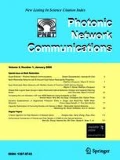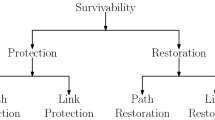Abstract
Multi-protocol lambda switching (MPλS) has recently been applied in the optical network control plane to provide fast lightpath provisioning. As an increasing amount of traffic is carried in optical transport networks (OTNs), single network failures can affect a vast amount of traffic, making lightpath protection crucial. Therefore, shared backup tree (BT) lightpath protection is a promising paradigm in MPλS networks due to its ability of fast recovery and its efficiency in consumed resources. A shared BT is used to protect a group of working lightpaths towards the same destination. From the working lightpaths in such a group, only one affected lightpath at a time can be recovered using the BT. The main problem is how to group and route the working paths (WPs) and how to route the BTs, in such a way that the capacity resources used by the WPs and the BTs are minimized. In Part One of this study (presented in this paper), we propose three approaches to cope with this problem. The first approach is a purely integer linear programming (ILP) based method. The second one is a combination of ILP and a heuristic technique. The last one is a purely heuristic approach. In this paper, these approaches are theoretically compared. In Part Two [1] of this study, several simulations are carried out in order to compare these approaches in terms of performance and computing effort. The experimental results are in line with the theoretical expectations.
Similar content being viewed by others
References
A. Groebbens, et al., Efficient protection in MPλS networks using backup trees: Part two—simulations, Photonic Network Communications, vol. 6,no. 3, (Nov. 2003), pp. 207-222.
D. Colle, MPLS recovery mechanisms for IP-over-WDM networks. Special issue on IP over WDM and Optical Packet Switching of Photonic Network Communications, vol. 3,no. 1, (January 2001), pp. 23-40.
D. Colle, et al., Porting MPLS-recovery techniques to the MPλS paradigm. Special issue on 'Protection and Survivability in Optical Networks' of 'Optical Networks Magazine', vol. 2,no. 3, (May 2001), pp. 29-47.
D. Colle, et al., Dimensioning reliable IP-over-DWDM networks. IP-over-DWDM Conference, (November 2000), Paris, France, CD-rom.
LION Deliverable D10. Multilayer resilient network planning and evaluation: preliminary results. (January 2001) (http://www.telecom.ntua.gr/lion).
R. K. Ahuja, T. L. Magnanti, J. L. Orlin, Network flows: theory, algorithms and applications (Prentice Hall, Englewood Cliffs, New Jersey, 1993).
T. L. Magnanti, L. A. Wolsey, Optimal Trees, in: Handbooks in Operations Research and Management Science, Volume 7, Chapter 9, eds. M. O. Ball et al. (Elsevier Science, Amsterdam, 1995).
Qwest Nationwide network: http://www.qwest.com/about/inside/network/nationip.html.
D. Stamatelakis, W. D. Grover, Network restorability design using pre-configured trees, cycles, and mixtures of pattern types, TRLabs Technical Report TR-1999-05, Issue 1.0, (October 2000).
R. R. Iraschko, M. H. MacGregor, W. D. Grover, Optimal capacity placement for path restoration in STM or ATM mesh-survivable networks. IEEE/ACM Transactions on Networking, vol. 6,no. 3, (June 1998), pp. 325-336.
Author information
Authors and Affiliations
Rights and permissions
About this article
Cite this article
Groebbens, A., Colle, D., Maesschalck, S.D. et al. Efficient Protection in MPλS Networks Using Backup Trees: Part One—Concepts and Heuristics. Photonic Network Communications 6, 191–206 (2003). https://doi.org/10.1023/A:1025691119148
Issue Date:
DOI: https://doi.org/10.1023/A:1025691119148




